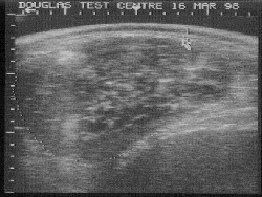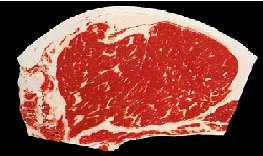Real-Time Ultrasound Evaluation of Carcass Traits
Ultrasound has been used to measure fat depth in beef cattle since the 1950's. Modern ultrasound technology can also measure ribeye area. This allows carcass composition to be evaluated more accurately. Research at the University of Saskatchewan indicates that ultrasound backfat and ribeye area measurements can accurately predict the lean meat yield of yearling bulls. This technology can be a valuable tool for seedstock producers interested in improving the carcass merit of their cattle.
Carcass traits are moderately to highly heritable. This means that the carcass characteristics of a bull will be passed on to his progeny, similar to average daily gain or weight per day of age. Furthermore, research indicates that there is as much variation within a breed as there is between breeds. Ultrasound technology allows a potential herd sire's carcass merit to be evaluated directly. This is faster and more cost effective than progeny testing.
Accuracy
These measurements have been collected and analyzed by technicians certified by the Animal Ultrasound Practitioners Association (AUP). Together with the Beef Improvement Federation (BIF), the AUP holds a clinic in which ultrasound technicians from across North America are tested for their ability to produce repeatable and accurate fat depth, ribeye area and intramuscular fat measurements in beef cattle. Technicians who meet predetermined standards are accredited by the AUP. Data collected by these technicians is accepted by some breed associations for use in EPDs.
What Do Ultrasound Measurements Tell Us?
Bull test indexes are based on average daily gain and weight per day of age. Ultrasound measurements go one step further, and indicate whether bulls are growing muscle (high lean meat yield) or fat (low lean meat yield).
Fat Depth
The fat depth (USFAT; mm) measurement is important for several reasons. Firstly, fat depth influences lean meat yield. Fat bulls have less lean meat in the carcass. Secondly, the fat measurement gives an indication of the bull's fleshing ability. Calves from a bull with no fat may finish too slowly in the feedlot. Body condition score (fat depth) in females is related to their ability to reach puberty at an early age, produce milk, rebreed, and maintain a short calving interval. On the other hand, bulls carrying excessive fat may suffer reduced fertility if not managed properly prior to the breeding season. In other words, extremely fat (low cutability) and extremely lean (high cutability) bulls are undesirable, regardless of the breeding objectives. Moderation is the key.

Ribeye Area and Weight Adjusted Ribeye Area
The ribeye is the largest muscle in the body, so ribeye area (USREA; cm2) gives an indication of overall carcass muscling. However, ribeye area is influenced by body weight. Within a breed, the largest ribeye muscle often belongs to the heaviest bull. As a result, ribeye area is also expressed on a weight adjusted basis (WREA; in2/100lbs). Adjusting ribeye area for body weight helps to determine which bulls are more muscular and which bulls are simply heavier.
Cutability
Cutability (USLEAN; % Lean Meat Yield) is the percentage lean meat yield in the carcass. Yield grade is an important factor in both Canada and the US. Producing calves with a high genetic potential for this trait can be an important objective of a breeding program.
What Cattle Should I Scan?
As with all traits, the more cattle that are measured, the more accurate and useful the genetic information will be. Ideally, all calves should be scanned at 12 months, regardless of whether they are to be sold, retained or culled. Picking and choosing which calves will be scanned can produce misleading results. Some breeders prefer to simply scan their bull calves to provide carcass information to their customers. In addition, since bulls typically produce more offspring than heifers, they tend to have a greater overall genetic impact. However, collecting heifer measurements will provide information about the genetics that are going back into your own herd as replacements.
When Should I Scan?
Cattle should be scanned as close as possible to one year of age (12 to 14 months). There are two reasons for this recommendation. Firstly, this is the age at which their progeny will likely begin to go to slaughter. Secondly, it a convenient time to scan, since post-weaning performance evaluations and structural and reproductive soundness exams are typically conducted at this age. There has been limited interest in scanning two year old bulls. However, these measurements cannot be compared to measurements collected on yearling bulls because they are at vastly different stages of maturity. Measuring two-year old bulls is not recommended, and these numbers cannot be used in a genetic evaluation. As well, the main advantage of ultrasound measurements is that they can be used to evaluate a bull before he is used for breeding. Waiting until a bull is two years old defeats this purpose.
Using Ultrasound Measurements in a Breeding Program
As with all genetic traits, ultrasound measurements should only be compared among animals of similar age and breed that have been managed under the same environment. Research at the University of Saskatchewan indicates that age adjustment of ultrasound measurement is of little benefit for comparing spring-born bulls, since there is little age variation to begin with. Since genetic improvement comes from within-breed selection, comparing measurements of individual animals from two different breeds is of little value. Finally, as with growth rate, carcass composition is partly dependent on the feeding program. Consequently, it is misleading to compare the ultrasound traits of bulls that have been developed on different rations. Until EPDs are developed for ultrasound traits, these measurements should only be used for comparing bulls within a breed at the same farm or test station.
Currently, the American Hereford Association and American Angus Association are developing EPDs for carcass trait based on ultrasound measurements. The importance of ultrasound measurements may increase in Canada as the trend towards North American EPDs continues.
Other Ultrasound Measurements
There are a variety of computer programs that have been developed to evaluate intramuscular fat percentage (ie marbling) based on analysis of real-time ultrasound images. These measurements are typically used more widely in the US, where the grading system and carcass value is based primarily on quality (marbling) grade.
A second system uses ultrasound information along with breed type, weight, frame score and estimated rate of gain to predict days on feed to a constant yield (lean meat yield) or quality (marbling) grade. If carcass weight and grade discounts are included, the optimum slaughter date can be predicted. This program has been developed for sorting feedlot cattle into carcass grade outcome groups.

Summary
The importance of carcass trait information will increase as value based marketing and quality assurance programs become more widespread. However, many other traits such as reproductive performance, structural soundness, calving ease, growth rate and birth, weaning and yearling weights must also be considered when incorporating carcass traits into a breeding program. Single trait selection is always discouraged. Moderation and balance are key ingredients of a successful breeding program.
